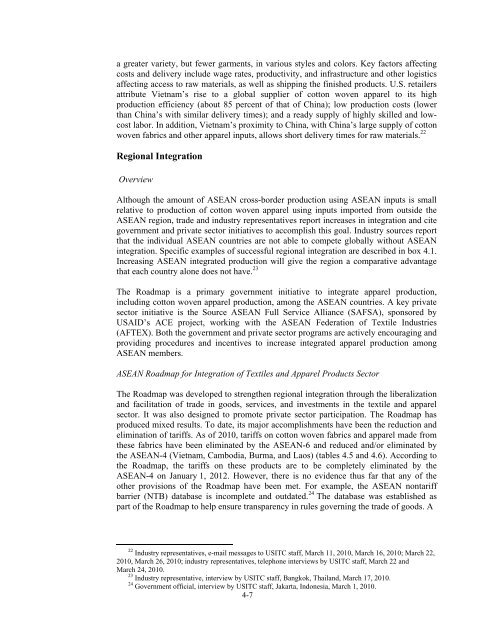ASEAN: Regional Trends in Economic Integration, Export ... - USITC
ASEAN: Regional Trends in Economic Integration, Export ... - USITC
ASEAN: Regional Trends in Economic Integration, Export ... - USITC
Create successful ePaper yourself
Turn your PDF publications into a flip-book with our unique Google optimized e-Paper software.
a greater variety, but fewer garments, <strong>in</strong> various styles and colors. Key factors affect<strong>in</strong>g<br />
costs and delivery <strong>in</strong>clude wage rates, productivity, and <strong>in</strong>frastructure and other logistics<br />
affect<strong>in</strong>g access to raw materials, as well as shipp<strong>in</strong>g the f<strong>in</strong>ished products. U.S. retailers<br />
attribute Vietnam’s rise to a global supplier of cotton woven apparel to its high<br />
production efficiency (about 85 percent of that of Ch<strong>in</strong>a); low production costs (lower<br />
than Ch<strong>in</strong>a’s with similar delivery times); and a ready supply of highly skilled and lowcost<br />
labor. In addition, Vietnam’s proximity to Ch<strong>in</strong>a, with Ch<strong>in</strong>a’s large supply of cotton<br />
woven fabrics and other apparel <strong>in</strong>puts, allows short delivery times for raw materials. 22<br />
<strong>Regional</strong> <strong>Integration</strong><br />
Overview<br />
Although the amount of <strong>ASEAN</strong> cross-border production us<strong>in</strong>g <strong>ASEAN</strong> <strong>in</strong>puts is small<br />
relative to production of cotton woven apparel us<strong>in</strong>g <strong>in</strong>puts imported from outside the<br />
<strong>ASEAN</strong> region, trade and <strong>in</strong>dustry representatives report <strong>in</strong>creases <strong>in</strong> <strong>in</strong>tegration and cite<br />
government and private sector <strong>in</strong>itiatives to accomplish this goal. Industry sources report<br />
that the <strong>in</strong>dividual <strong>ASEAN</strong> countries are not able to compete globally without <strong>ASEAN</strong><br />
<strong>in</strong>tegration. Specific examples of successful regional <strong>in</strong>tegration are described <strong>in</strong> box 4.1.<br />
Increas<strong>in</strong>g <strong>ASEAN</strong> <strong>in</strong>tegrated production will give the region a comparative advantage<br />
that each country alone does not have. 23<br />
The Roadmap is a primary government <strong>in</strong>itiative to <strong>in</strong>tegrate apparel production,<br />
<strong>in</strong>clud<strong>in</strong>g cotton woven apparel production, among the <strong>ASEAN</strong> countries. A key private<br />
sector <strong>in</strong>itiative is the Source <strong>ASEAN</strong> Full Service Alliance (SAFSA), sponsored by<br />
USAID’s ACE project, work<strong>in</strong>g with the <strong>ASEAN</strong> Federation of Textile Industries<br />
(AFTEX). Both the government and private sector programs are actively encourag<strong>in</strong>g and<br />
provid<strong>in</strong>g procedures and <strong>in</strong>centives to <strong>in</strong>crease <strong>in</strong>tegrated apparel production among<br />
<strong>ASEAN</strong> members.<br />
<strong>ASEAN</strong> Roadmap for <strong>Integration</strong> of Textiles and Apparel Products Sector<br />
The Roadmap was developed to strengthen regional <strong>in</strong>tegration through the liberalization<br />
and facilitation of trade <strong>in</strong> goods, services, and <strong>in</strong>vestments <strong>in</strong> the textile and apparel<br />
sector. It was also designed to promote private sector participation. The Roadmap has<br />
produced mixed results. To date, its major accomplishments have been the reduction and<br />
elim<strong>in</strong>ation of tariffs. As of 2010, tariffs on cotton woven fabrics and apparel made from<br />
these fabrics have been elim<strong>in</strong>ated by the <strong>ASEAN</strong>-6 and reduced and/or elim<strong>in</strong>ated by<br />
the <strong>ASEAN</strong>-4 (Vietnam, Cambodia, Burma, and Laos) (tables 4.5 and 4.6). Accord<strong>in</strong>g to<br />
the Roadmap, the tariffs on these products are to be completely elim<strong>in</strong>ated by the<br />
<strong>ASEAN</strong>-4 on January 1, 2012. However, there is no evidence thus far that any of the<br />
other provisions of the Roadmap have been met. For example, the <strong>ASEAN</strong> nontariff<br />
barrier (NTB) database is <strong>in</strong>complete and outdated. 24 The database was established as<br />
part of the Roadmap to help ensure transparency <strong>in</strong> rules govern<strong>in</strong>g the trade of goods. A<br />
22 Industry representatives, e-mail messages to <strong>USITC</strong> staff, March 11, 2010, March 16, 2010; March 22,<br />
2010, March 26, 2010; <strong>in</strong>dustry representatives, telephone <strong>in</strong>terviews by <strong>USITC</strong> staff, March 22 and<br />
March 24, 2010.<br />
23 Industry representative, <strong>in</strong>terview by <strong>USITC</strong> staff, Bangkok, Thailand, March 17, 2010.<br />
24 Government official, <strong>in</strong>terview by <strong>USITC</strong> staff, Jakarta, Indonesia, March 1, 2010.<br />
4-7

















